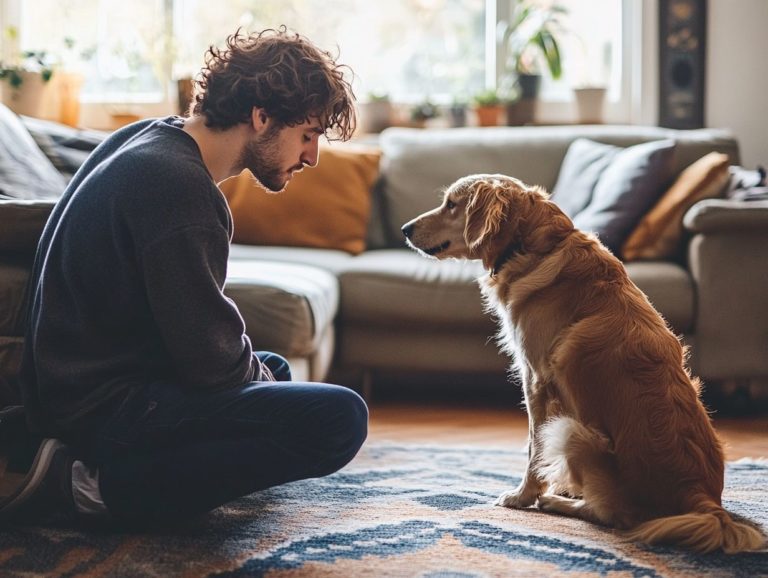Understanding Fears in Pets: A Training Perspective
Fear in pets is more prevalent than you might think. It can profoundly affect their behavior and overall well-being. Whether it s fear of loud noises, unfamiliar faces, or anxiety from separation, these fears can trigger concerning behavioral changes.
This article delves into the root causes of fear in pets and outlines effective training techniques. These include positive reinforcement and the option of seeking professional help.
It addresses specific fears and provides valuable tips for preventing anxiety through early socialization and creating a secure environment.
By understanding and tackling your pet’s fears, you can pave the way for a happier and healthier life for both you and your beloved companion.
Contents
- Key Takeaways:
- The Impact of Fear on Pets
- Training Methods for Fearful Pets
- Addressing Specific Fears in Pets
- Preventing Fear in Pets
- Frequently Asked Questions
- What is the training perspective on understanding fears in pets?
- Why is it important to understand fears in pets from a training perspective?
- What are some common fears in pets?
- How can training help reduce fears in pets?
- What are some signs that my pet might be scared?
- Can fears in pets be completely eliminated through training?
Key Takeaways:

- Understanding the root causes of fear in pets helps owners manage their pet’s fears effectively.
- Fear can have serious behavioral and health effects, making it crucial for owners to address their pet s fears.
- Using positive reinforcement techniques and working with a professional trainer can greatly improve a fearful pet’s behavior and overall well-being.
What Causes Fear in Pets?
Understanding what causes fear in pets is essential for pet owners who want to help their furry companions manage anxiety and phobias effectively. Fear can arise from sources like loud noises, unfamiliar environments, or traumatic experiences. These may lead to behaviors like barking, hiding, or even destructive actions. By identifying the root causes, you can provide better care and treatment for your pets’ mental health.
Environmental factors play a significant role. Common triggers like thunderstorms and fireworks often leave pets feeling helpless and terrified. Past trauma from an abusive situation or abandonment can create lasting scars, making certain situations particularly distressing. Genetics can also influence how fear shows up in pets, with some breeds predisposed to heightened anxiety levels.
Seeking advice from veterinary behaviorists can be incredibly beneficial. These professionals can help diagnose specific fears and recommend effective strategies, such as gradual exposure methods and changing behavior, to enhance the overall well-being of your anxious pets.
The Impact of Fear on Pets
The impact of fear on pets can be profound, shaping their behavior and overall health and well-being. You might notice fear manifesting in various ways, such as excessive barking, hiding, or even aggressive reactions.
If these anxious responses go unaddressed, they can lead to serious health issues over time. As a caring pet owner, understanding fear s impact is vital for your pet’s happiness.
Behavioral Changes and Health Effects
Behavioral changes in pets stemming from fear can profoundly impact both their health and overall quality of life. Common signs include excessive barking, withdrawal, or even destructive behaviors. Each of these can intensify emotional distress and elevate anxiety levels.
Recognizing these changes is vital, as the mental and physical health of animals are intricately linked. A pet showing fear-based behaviors could develop gastrointestinal issues, experience weight loss, or suffer from skin conditions due to stress.
While veterinary treatments like anti-anxiety medications and pheromone diffusers can offer relief, behavior modification techniques such as gradual exposure methods and positive reinforcement training often produce more lasting results.
Acting quickly can make a world of difference for your pet s well-being. Addressing fear-related concerns promptly can prevent long-term behavioral problems, cultivating a more stable and joyful environment for both you and your pets.
Training Methods for Fearful Pets
Training methods for fearful pets are essential in helping them conquer anxiety and foster confidence in their surroundings. By employing techniques like positive reinforcement, you can cultivate an atmosphere of safety and trust.
You can help your pet gradually confront their fears, supported by the expertise of skilled trainers or veterinary behaviorists. By grasping these methods, you can effectively aid your anxious companion on their journey to a more confident and relaxed state.
Positive Reinforcement Techniques

Positive reinforcement techniques are effective for training fearful pets. They foster trust and encourage desired behaviors through rewards.
By consistently rewarding calm and confident actions, you can modify your pet’s fearful responses. This helps them navigate stressful situations with greater ease.
This approach enhances your pet’s emotional state and deepens the bond between you and your furry companion.
For instance, when introducing your pet to a new environment, offering treats for exploring or even just observing can significantly reduce their anxiety. Using toys or praise as rewards after a successful interaction with another pet or person reinforces their confidence.
This method can work wonders during stressful situations like vet visits or car rides. By consistently applying these techniques, you build trust over time, showing your pet that they are in a safe space.
Ultimately, this not only aids in their training but also greatly contributes to their overall well-being and happiness.
Partnering with a Trainer for Success
Working with a professional trainer can offer you invaluable support if you re an owner of a fearful pet. They provide a tailored approach to address specific behavioral issues.
Trainers often with backgrounds as veterinary behaviorists understand the nuances of animal anxiety and possess proven techniques to help alleviate stress.
Their expertise allows them to dissect behaviors and develop customized training plans that cater to your pet s unique triggers and personality. This careful attention creates a safer, more effective learning environment.
By fostering a positive relationship between the trainer and your animal, you gain confidence in managing your pet s fears. This transforms the training experience into a collaborative journey toward comfort and stability.
Addressing Specific Fears in Pets
Addressing your pet’s specific fears, such as noise phobias and separation anxiety, demands a thoughtful approach that integrates both training and treatment options. Many pets experience significant distress during loud occurrences like thunderstorms and fireworks. Others may struggle profoundly with being away from you.
Acknowledging these fears is the crucial first step in delivering effective support for your anxious companion.
Noise Phobias
Noise phobias, marked by an intense fear of loud sounds such as thunderstorms and fireworks, rank among the most prevalent anxieties pets experience. These phobias can lead to distressing behaviors like excessive barking, hiding, and frantic attempts to escape.
A good plan can help your pet get used to loud noises. Implementing a thoughtful treatment plan that includes exposure therapy and desensitization can ease these fears.
It s essential for you, as a pet owner, to recognize the early signs of this condition, which may manifest as trembling, panting, or clinginess during noisy events. Veterinary insights emphasize the importance of a comprehensive assessment to tailor stress management techniques that fit your pet’s specific needs.
Strategies like counter-conditioning, where your pet is gradually exposed to the sounds in a controlled setting along with positive reinforcement, can effectively transform their emotional response. You can create a designated safe space and utilize calming products, such as pheromone diffusers or anxiety wraps, to provide additional support.
With patience and consistency, you can cultivate a more serene environment for your anxious companion. Start using these techniques today to see improvement in your pet s behavior!
Preventing Fear in Pets

Preventing fear in your pets is an active process that starts with early socialization and techniques to help them get used to things that make them nervous. By creating a safe and comfortable environment, you enable your pets to explore and adapt without fear.
This significantly reduces the chances of anxiety developing later on. This forward-thinking approach is vital for ensuring that your pets lead healthy and joyful lives.
Socialization and Separation Anxiety
Socialization is essential for a happy pet. It helps in preventing separation anxiety, making them feel secure whether they re alone or in different environments. When pets are well-socialized, they re more likely to develop healthier interactions and trust in you.
To achieve this, integrate practical techniques into your pet s daily routine. Engaging them in group classes or playdates with other animals introduces new experiences and builds their confidence. Exposing your pets to various people and environments while rewarding their calm behavior fosters trust and security.
Creating a treatment plan that incorporates gradual desensitization, like starting with short departures that gradually increase in duration, can also help curb separation anxiety. Ensuring consistent interactions and supportive training methods will lead to a well-adjusted pet who copes better with being alone.
Early Socialization and Desensitization
Early socialization and desensitization are crucial in shaping your pet s response to various stimuli and environments. By exposing your pets to different people, animals, and situations at a young age, you help them adapt and build resilience.
This significantly reduces anxiety as they grow. Introducing a puppy to various sound environments like bustling streets or lively dog parks can help them get used to noises that might otherwise trigger fear.
Similarly, arranging playdates with various breeds teaches your pet appropriate interaction. Gradual exposure to scenarios like car rides or vet visits influences their comfort levels.
Over time, these practices yield long-term benefits, such as reduced anxiety and a stronger bond between you and your pet. Employing techniques like positive reinforcement can enhance this process.
Creating a Safe and Comfortable Environment
Building a cozy haven for your pets is essential in helping them feel secure and reducing anxiety levels. A thoughtfully structured space that caters to their needs can enhance their overall well-being.
Key elements to consider include:
- Minimizing clutter to reduce stress and distractions.
- Establishing quiet zones for relaxation.
- Incorporating comfort items such as soft bedding, familiar toys, and calming pheromone diffusers.
Techniques like positive reinforcement and gentle handling during veterinary visits also support anxious pets. By focusing on these aspects, you have the power to create a nurturing sanctuary that promotes emotional and physical well-being for your companions.
Frequently Asked Questions
What is the training perspective on understanding fears in pets?
The training perspective on understanding fears in pets involves using positive reinforcement techniques to help pets overcome their fears, such as fear of thunderstorms and fireworks, in a safe and effective manner. By understanding the anxiety spectrum in pets, owners can better tailor their approach to each individual animal.
Start your journey today to keep your pets happy and calm!
Why is it important to understand fears in pets from a training perspective?

Understanding your pet’s fears is crucial for their happiness and your peace of mind! When you know what scares your pet, you can help them feel safe and improve their behavior.
What are some common fears in pets?
Common fears in pets include loud noises, unfamiliar people or animals, and new environments. These fears can cause them to bark or hide.
How can training help reduce fears in pets?
Training helps reduce fears by gradually exposing pets to what scares them in a controlled way. For more effective strategies, consider understanding the needs of anxious pets. Over time, they can learn to feel safe and associate these fears with something positive.
What are some signs that my pet might be scared?
Watch for signs like trembling, hiding, excessive barking or meowing, and panting. Recognizing these signs is key to helping your pet.
Can fears in pets be completely eliminated through training?
While fears may not be completely eliminated, training can teach pets to manage and cope with their fears. This makes managing situations like thunderstorms or fireworks much easier!






